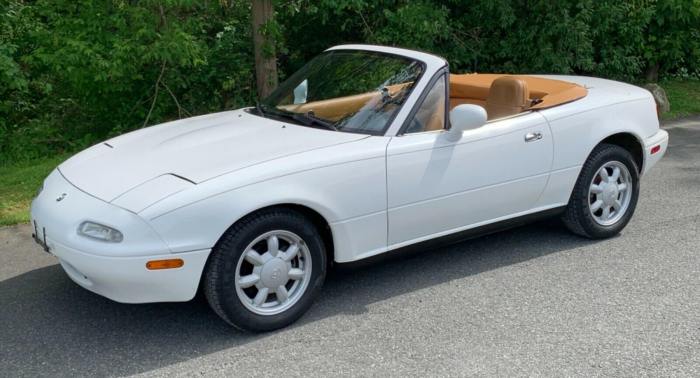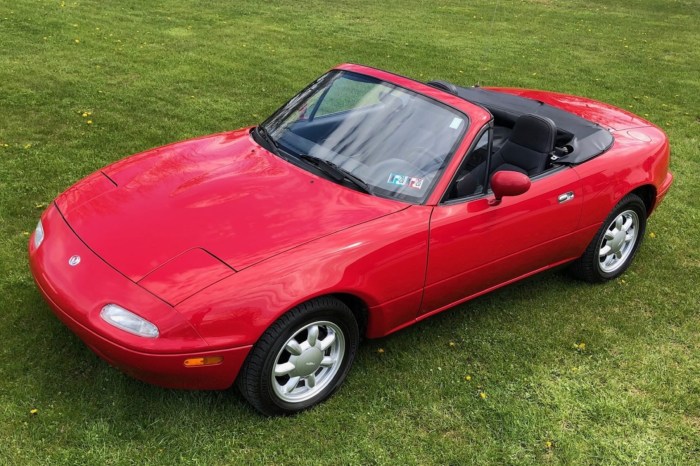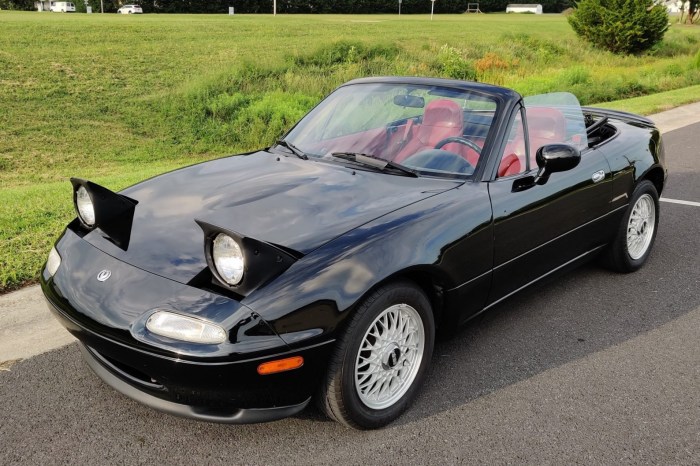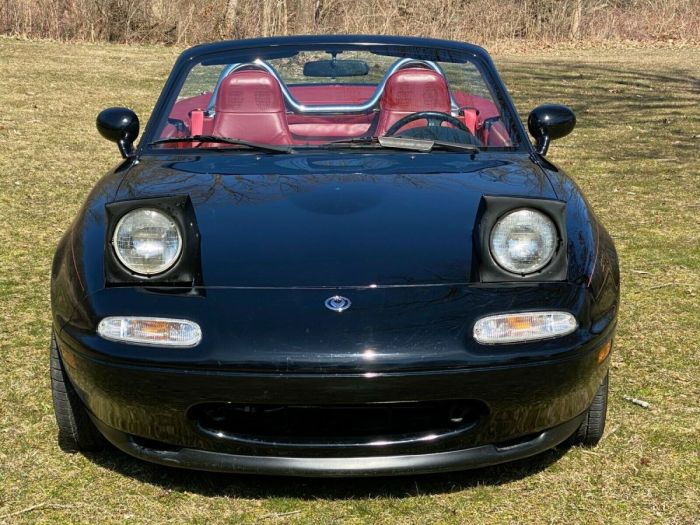The 1993 Mazda MX-5 Miata, a name synonymous with driving pleasure, burst onto the scene as a breath of fresh air in the automotive world. This lightweight roadster, a revival of the classic British sports car, captivated enthusiasts with its nimble handling, engaging performance, and timeless design.
The Miata’s arrival marked a resurgence of the roadster genre, igniting a passion for open-top driving that continues to this day.
Its simple yet effective design, coupled with a potent yet fuel-efficient engine, made the 1993 Miata a true driver’s car. It was a machine that emphasized the joy of driving, offering a pure and unadulterated experience that resonated with both seasoned enthusiasts and newcomers alike.
This iconic car’s legacy extends far beyond its initial success, influencing generations of roadsters and solidifying its place as a timeless classic.
Introduction

The 1993 Mazda MX-5 Miata is a legendary sports car that revolutionized the roadster market and cemented its place in automotive history. This iconic model, launched in 1989, became an instant sensation for its affordable price, lightweight design, and exhilarating driving experience.
The 1993 model year marked a significant milestone for the Miata, introducing several refinements that further enhanced its performance and appeal. The Miata’s success can be attributed to its carefully crafted design philosophy, which prioritized driving pleasure and affordability. It was engineered to be a pure driving machine, offering a direct connection between driver and road.
Impact on the Roadster Market
The 1993 Miata’s impact on the roadster market was undeniable. It reignited interest in this segment, inspiring other manufacturers to introduce their own interpretations of the lightweight, open-top sports car. The Miata’s success proved that there was a significant market for affordable, fun-to-drive roadsters, and its influence can still be seen in modern-day models like the Mazda MX-5 and the Fiat 124 Spider.The Miata’s legacy extends beyond its commercial success.
It became a symbol of affordable driving enjoyment, fostering a passionate community of enthusiasts worldwide. The Miata’s simple, yet effective design has inspired countless modifications and customizations, showcasing the car’s versatility and enduring appeal.
Performance and Handling

The 1993 Mazda MX-5 Miata, often referred to as the NA generation, was lauded for its exceptional handling and engaging driving experience, making it a true driver’s car. This section delves into the specifics of the Miata’s performance and handling characteristics, highlighting its key strengths and how it compared to other sports cars of the era.
Engine Specifications and Performance
The 1993 Miata was powered by a 1.6-liter naturally aspirated four-cylinder engine, producing 115 horsepower and 98 lb-ft of torque. This engine, coupled with the Miata’s lightweight design, resulted in a spirited driving experience. The car’s power-to-weight ratio was impressive for its time, contributing to its quick acceleration and nimble handling.
The Miata offered a choice of transmissions: a 5-speed manual or a 4-speed automatic. The manual transmission was the preferred choice for enthusiasts, offering a more engaging and direct driving experience.
Suspension and Steering Setup
The 1993 Miata featured a double wishbone front suspension and a multilink rear suspension, designed for precise handling and a comfortable ride. The suspension was tuned to provide a balance between sportiness and everyday usability. The car’s steering was known for its responsiveness and accuracy, giving drivers a strong sense of connection to the road.
Comparison to Contemporary Sports Cars
While the 1993 Miata didn’t boast the highest horsepower figures compared to other sports cars of its era, its lightweight design and excellent handling made it a formidable contender. The Miata’s agility and responsiveness on winding roads were unmatched by many of its contemporaries.
For example, compared to the Honda CRX Si, the Miata offered a more engaging driving experience, with its lighter weight and more balanced handling characteristics.
Design and Aesthetics
The 1993 Mazda MX-5 Miata is a testament to the power of simplicity and timeless design. Its sleek lines and compact proportions have captivated drivers for decades, solidifying its status as a modern classic. The Miata’s design philosophy prioritizes functionality and driver engagement, resulting in a car that is both visually appealing and a joy to drive.
Exterior Design
The Miata’s exterior design is characterized by its iconic lines and proportions. The long hood, short overhangs, and wide stance give the car a sporty and agile appearance. The rounded headlights, small grille, and low-slung profile contribute to its charming and approachable aesthetic.
The Miata’s design is a masterclass in simplicity, with every element serving a purpose. The curves and angles of the bodywork are not merely decorative; they are carefully sculpted to optimize aerodynamics and handling.
Interior Design
The interior of the 1993 Miata is equally focused on simplicity and functionality. The dashboard is uncluttered and driver-oriented, with large, easy-to-read gauges and controls within easy reach. The seats are supportive and comfortable, providing a good balance of comfort and lateral support.
While the interior is not as luxurious as some of its competitors, it is well-built and functional. The focus on driver engagement is evident in the car’s ergonomics, with everything designed to enhance the driving experience.
Dimensions Compared to Other Roadsters, 1993 Mazda MX-5 Miata
The 1993 Miata’s compact dimensions make it a nimble and fun-to-drive car. To illustrate this, here is a table comparing its dimensions to other popular roadsters of the era:| Model | Length (in) | Width (in) | Height (in) | Wheelbase (in) ||—|—|—|—|—|| 1993 Mazda MX-5 Miata | 152.2 | 65.8 | 49.4 | 89.4 || 1993 Honda CRX | 152.4 | 65.4 | 50.2 | 95.1 || 1993 Toyota MR2 | 152.4 | 66.5 | 49.2 | 93.7 || 1993 MG MGF | 153.5 | 67.1 | 48.8 | 94.5 |As the table shows, the Miata is one of the smallest and most compact roadsters of its era.
This contributes to its agility and maneuverability, making it a joy to drive on winding roads.
The 1993 Mazda MX-5 Miata, with its lightweight design and nimble handling, quickly became a favorite among enthusiasts. While the Miata focused on pure driving pleasure, Mazda was also experimenting with more advanced technology, as seen in the 1990 Mazda Cosmo , which featured a rotary engine and a sophisticated four-wheel steering system.
The Miata’s success, however, cemented its place as a timeless icon, showcasing Mazda’s commitment to creating fun-to-drive vehicles.
Ownership and Maintenance

The 1993 Mazda MX-5 Miata, a renowned roadster, offers a delightful driving experience. However, owning and maintaining one requires understanding its reliability, common issues, and associated costs. This section delves into these aspects, providing valuable insights for prospective and current Miata owners.
Reliability and Common Maintenance Issues
The 1993 Miata is generally considered a reliable car, but like any vehicle, it has its share of common maintenance issues. These issues are often related to the car’s age and mileage.
- Engine:The 1.6-liter engine is known for its durability but can develop issues with oil leaks, valve seals, and timing belt wear over time. Regular maintenance, including oil changes and timing belt replacements, is crucial.
- Transmission:The 5-speed manual transmission is robust, but it’s important to check for gear synchro issues and clutch wear. A smooth shifting experience is vital for enjoying the Miata’s driving dynamics.
- Suspension:The Miata’s suspension components can wear out, especially if the car has been driven aggressively. Common issues include worn ball joints, tie rod ends, and shocks.
- Electrical System:The electrical system, while generally reliable, can experience issues with the alternator, starter, and wiring. Regular checks and maintenance are essential.
- Rust:Miatas produced in the early 1990s are prone to rust, particularly in areas like the wheel wells, rocker panels, and underbody. Regular inspections and prompt rust treatment are crucial for preserving the car’s integrity.
Parts Availability and Cost of Ownership
The 1993 Miata enjoys excellent parts availability, thanks to its popularity and the aftermarket support it receives. Many parts, including engine components, suspension parts, and body panels, are readily available from both OEM and aftermarket suppliers. However, it’s important to be mindful of the cost of parts and labor, which can vary depending on the specific component and the mechanic’s expertise.
The 1993 Mazda MX-5 Miata, a timeless classic, was a testament to Mazda’s dedication to pure driving pleasure. While the 1993 model was a hit, Mazda continued to refine the formula, leading to the release of the 1995 Mazda MX-5 Miata , which boasted several improvements, including a more powerful engine and a revised suspension.
Both models, however, remain highly sought-after by enthusiasts who appreciate their nimble handling and engaging driving experience.
- OEM Parts:Original equipment manufacturer (OEM) parts are typically more expensive but offer the best fit and quality. They can be sourced from authorized Mazda dealerships or online retailers.
- Aftermarket Parts:Aftermarket parts are often more affordable than OEM parts, but their quality can vary. It’s crucial to choose reputable aftermarket brands to ensure reliable performance and durability.
- Labor Costs:Labor costs for repairs and maintenance can vary significantly depending on the location and the mechanic’s experience. It’s wise to shop around for competitive rates and obtain multiple quotes before committing to a repair.
Finding and Restoring a 1993 Miata
Finding a 1993 Miata in good condition requires careful inspection and due diligence. The following tips can help you locate a well-maintained example:
- Thorough Inspection:Inspect the car’s exterior for rust, dents, and scratches. Check the engine bay for leaks, corrosion, and signs of neglect. Test drive the car to assess its overall performance, including engine smoothness, transmission shifting, and suspension response.
- Service History:Request the car’s service history from the seller to verify regular maintenance and any major repairs performed. This information can provide valuable insights into the car’s condition and its potential future maintenance needs.
- Independent Inspection:Consider having the car inspected by a qualified mechanic to get an unbiased assessment of its condition. This can help you avoid costly surprises later on.
- Restoration:If you find a Miata that needs some restoration work, be prepared for the time, effort, and potential expense involved. It’s essential to have a realistic budget and a clear plan for the restoration process.
Cultural Impact and Legacy

The 1993 Mazda MX-5 Miata, beyond its mechanical prowess, left an indelible mark on popular culture, becoming an icon that transcended its status as a mere car. Its influence extended to movies, TV shows, and even the design of subsequent generations of roadsters.
Appearances in Media
The Miata’s charming design and engaging driving experience made it a natural choice for appearances in various forms of media. Its presence in movies and TV shows contributed to its popularity and solidified its image as a fun, accessible, and desirable car.
- The 1993 Miata made its big-screen debut in the 1995 film “Clueless,” driven by the character Cher Horowitz. This appearance helped solidify the Miata’s association with youth culture and a sense of carefree driving.
- In the popular TV series “Friends,” the character of Monica Geller owned a 1993 Miata, further showcasing the car’s appeal to a wide audience.
- The Miata’s presence in video games, such as “Grand Theft Auto: San Andreas,” further cemented its place in popular culture and allowed players to experience the car’s driving characteristics in a virtual environment.
Influence on Subsequent Generations of Roadsters
The 1993 Miata’s success paved the way for a resurgence in the roadster market, inspiring manufacturers to develop their own interpretations of the lightweight, rear-wheel-drive formula.
- The Honda S2000, launched in 1999, was directly inspired by the Miata, featuring a similar lightweight design and a high-revving engine.
- The Toyota MR2 Spyder, introduced in 2000, adopted the Miata’s philosophy of affordability and driving enjoyment, offering a more compact and sporty driving experience.
Notable Events and Milestones
The 1993 Miata’s journey was marked by several significant events and milestones that contributed to its lasting legacy.
- In 1990, the Miata was named “Car of the Year” by -Motor Trend*, a prestigious award that recognized its innovative design and driving dynamics.
- The Miata achieved a sales milestone of 1 million units in 2000, solidifying its position as one of the most successful roadsters ever produced.
- In 2010, the Miata was inducted into the -Automotive Hall of Fame*, a testament to its enduring impact on the automotive industry.
Driving Experience: 1993 Mazda MX-5 Miata

The 1993 Mazda MX-5 Miata is more than just a car; it’s a driving experience. Its compact size, nimble handling, and engaging powertrain create a connection between driver and machine that’s hard to find in modern vehicles. This section explores the nuances of driving the Miata, delving into its handling, acceleration, and the overall sensation of being behind the wheel.
Driving Dynamics and Handling
The Miata’s driving dynamics are defined by its lightweight construction, perfectly balanced chassis, and responsive steering. With a 50/50 weight distribution, the car feels incredibly agile, making it a joy to navigate corners. The short wheelbase allows for quick turn-in, and the precise steering provides excellent feedback, allowing the driver to feel the road surface and adjust their line with confidence.
“The Miata is like a dancer, light on its feet and always ready to move.”
A Miata owner
Acceleration and Power
While the Miata’s 1.6-liter engine may not be the most powerful, it’s surprisingly peppy. The engine’s rev-happy nature encourages spirited driving, and the short gearing makes acceleration feel lively. The Miata’s low weight further enhances its acceleration, making it surprisingly quick off the line.
Driving Anecdotes
Many Miata owners describe the driving experience as exhilarating and rewarding. They often mention the car’s ability to make them feel connected to the road and the joy of pushing it to its limits. The Miata’s simplicity and ease of use allow drivers of all skill levels to enjoy its driving dynamics.
“I’ve owned my Miata for over 20 years, and it still puts a smile on my face every time I drive it. It’s the perfect car for a weekend drive or a spirited run through the canyons.”
A long-time Miata owner
Comparison with Other Roadsters
| Feature | 1993 Mazda MX-5 Miata | 1991 Honda CRX Si | 1989 Fiat 124 Spider |
|---|---|---|---|
| Handling | Precise and responsive | Agile and fun | Sporty and balanced |
| Acceleration | Lively and engaging | Quick and rev-happy | Adequate and enjoyable |
| Overall Driving Experience | Exhilarating and rewarding | Fun and engaging | Classic and engaging |
Last Point

The 1993 Mazda MX-5 Miata stands as a testament to the enduring appeal of pure driving pleasure. Its legacy lives on, inspiring countless enthusiasts and serving as a benchmark for the roadster genre. Whether you’re a seasoned driver or a curious newcomer, the 1993 Miata offers a timeless experience that will leave a lasting impression.